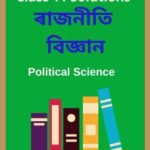Class 11 Political Science MCQ Chapter 1 Constitution: Why and How? Solutions to each chapter is provided in the list so that you can easily browse through different chapters Class 11 Political Science MCQ Chapter 1 Constitution: Why and How? Notes and select need one. Class 11 Political Science MCQ Chapter 1 Constitution: Why and How? Question Answers Download PDF. NCERT Political Science MCQ Class 11 Solutions.
Class 11 Political Science MCQ Chapter 1 Constitution: Why and How?
Also, you can read the NCERT book online in these sections Solutions by Expert Teachers as per Central Board of Secondary Education (CBSE) Book guidelines. AHSEC Class 11 Political Science Part – I and Part – II MCQ Solutions are part of All Subject Solutions. Here we have given NCERT Class 11 Political Science Multiple Choice Notes, Assam Board Class 11 Political Science Objective Type Solutions for All Chapters, You can practice these here.
Constitution: Why and How?
Chapter: 1
| (PART-A) INDIAN CONSTITUTION AT WORK |
| MCQ |
1. Who decides how the government Will it be Constituted?
(a) Parliament.
(b) Constitution.
(c) Judiciary.
(d) None of these.
Ans: (b) Constitution.
2. What is the Constitution?
(a) A written document with the laws and principles.
(b) A list of government officials.
(c) A collection of court decisions.
(d) A set of religious texts.
Ans: (a) A written document with the laws and principles.
3. Why is a Constitution necessary?
(a) To maintain order in society.
(b) To protect individual rights.
(c) To define the power of government.
(d) All of the above.
Ans: (d) All of the above.
4. Which of the following is not the purpose of a Constitution?
(a) Safeguarding freedom.
(b) Regulating foreign trade.
(c) Defining citizenship.
(d) Establishing government structure.
Ans: (b) Regulating foreign trade.
5. The Constitution of a country is:
(a) Temporary set of rules.
(b) A permanent document.
(c) Can be amended as per necessity.
(d) Both (b) and (c).
Ans: (d) Both (b) and (c).
6. What is a Constitution?
(a) It is a supreme law.
(b) It is a set of fundamental rules and principles.
(c) It is a compact written document.
(d) All of these.
Ans: (d) All of these.
7. A Constitution is a body of:
(a) Basic laws.
(b) Rules.
(c) Principles.
(d) Moral values.
Ans: (a) Basic laws.
8. When did the Constitution of India come into force?
(a) January 26, 1949
(b) November 26, 1949
(c) January 26, 1950
(d) December 25, 1949
Ans: (c) January 26, 1950
9. Who was the Chairman of Drafting Committee of Constitution?
(a) Dr. B.R. Ambedkar.
(b) Dr. Rajendra Prasad.
(c) V.V. Giri.
(d) H.P. Modi.
Ans: (a) Dr. B.R. Ambedkar.
10. How many members were there to append their signature to the Constitution as finally passed?
(a) 365 members.
(b) 196 members.
(c) 284 members.
(d) 106 members.
Ans: (c) 284 members.
11. Who was the President of the Constituent Assembly?
(a) Dr. Rajendra Prasad.
(b) Dr. B.R. Ambedkar.
(c) H.P. Modi.
(d) J.L. Nehru.
Ans: (a) Dr. Rajendra Prasad.
12. Which of these is not a function of the Constitution?
(a) It gives a guarantee of the rights of the citizens.
(b) The marks out different spheres of power for different branches of government.
(c) It ensures that good people come to power.
(d) It gives expression to some shared values.
Ans: (c) It ensures that good people come to power.
13. Indian borrowed the Directive Principles of State Policy from the:
(a) Irish Constitution.
(b) Canadian Constitution.
(c) British Constitution.
(d) South African Constitution.
Ans: (a) Irish Constitution.
14. Objective of the Constitution is:
(a) Justice.
(b) Equality.
(c) Liberty.
(d) All of these.
Ans: (d) All of these.
15. Which country has the unwritten Constitution?
(a) Britain.
(b) USA.
(c) India.
(d) Switzerland.
Ans: (a) Britain.

Hi! my Name is Parimal Roy. I have completed my Bachelor’s degree in Philosophy (B.A.) from Silapathar General College. Currently, I am working as an HR Manager at Dev Library. It is a website that provides study materials for students from Class 3 to 12, including SCERT and NCERT notes. It also offers resources for BA, B.Com, B.Sc, and Computer Science, along with postgraduate notes. Besides study materials, the website has novels, eBooks, health and finance articles, biographies, quotes, and more.



